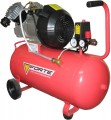Drive
The method of transferring rotation from the motor shaft to the working mechanism of the compressor.
— Straight. In
direct drive compressors, the operating mechanism shaft is aligned directly with the motor shaft — therefore, such models are also called coaxial. Their main advantage is the low cost due to the simplicity of the design, as well as the small dimensions of the compressor unit. However, this simplicity does not extend to repairs: it is likely that even with a small malfunction, you will have to disassemble most of the device. In addition, this option is characterized by a high level of noise, and the speed of rotation of the shaft is quite high, which greatly wears out the working mechanism. It is very difficult to create a high-performance compressor based on a direct drive, because design features adversely affect cooling efficiency. Therefore, such models usually belong to entry-level devices with low performance.
—
Belt. The operation of this drive is based on the use of two pulleys (one on the motor shaft, the other on the shaft of the working mechanism) connected by a drive belt. It is more bulky, somewhat more complex in design and more expensive than a straight line, but outperforms it in a number of other indicators. First of all, this is performance: separately located engine and working mechanism is much easier to cool, which allows you to create compressors of almost
...any capacity without the risk of overheating. In addition, due to the difference in the diameter of the pulleys, the speed of rotation of the shaft of the working mechanism is lower than that of the engine, which further reduces heating and has a positive effect on the resource. Belt-driven compressors are easy to repair and maintain (due to the ability to access the engine and mechanism separately), and their noise level is low.Rated pressure
The maximum pressure created by the compressor during operation. This parameter, as well as the performance described above, is very important for selecting a compressor for a specific pneumatic tool: it is necessary that the nominal pressure be not lower than the working pressure of the tool. At the same time, high pressure is not a problem — it can be reduced by the appropriate regulator on the gearbox.
Most modern compressors have a
pressure rating of 8 bar, which is sufficient for most air tools. Units for 6 bar belong to the entry level, their main purpose is painting work, where high pressure is not required. There are also options for 10 bar and even more — they, usually, belong to specialized models and cost accordingly. Therefore, it is worth looking specifically for a high-pressure unit only if this parameter is critical for the planned work (for example, if you need a compressor for tyre fitting).
When selecting according to the nominal pressure, it must be taken into account that the maximum allowable pressure in the receiver is usually indicated as the nominal pressure. The pressure actually given out by the compressor to the outlet is often somewhat less, this is due to some design features. For the most popular nominal pressure options — 8 and 10 bar — the real figures are usually 2 bar less, i.e. 6 and 8 bar respectively.
Rotation speed
The speed of rotation of the compressor motor shaft in normal operation. This parameter, usually, does not affect the efficiency of the unit — the main indicators are still the performance and nominal pressure (see above). At the same time, it allows you to evaluate the design features of the compressor and its durability. The fact is that a higher rotation speed allows the use of fairly simple and inexpensive working mechanisms, but it increases the wear of moving parts and reduces the motor resource. Therefore, a model with a lower number of revolutions is likely to cost more than the "high-speed" version, but it will also last longer (ceteris paribus characteristics — performance, pressure, drive type, design; see all above).

